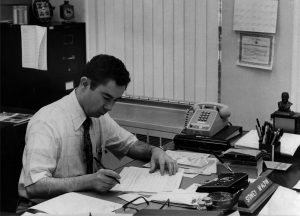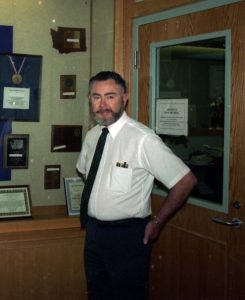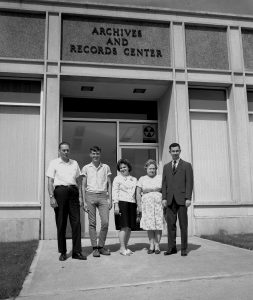On February 5, 2020 Washington lost Sidney (“Sid”) McAlpin, who had led the Washington State Archives as State Archivist from 1963 to 1994. Mike Saunders broke the sad news to Secretary of State’s office employees in an email, writing that, “To those of us who worked in the State Archives in the 1970s, 1980s and 1990s, Sid was not only our leader, he was [a] friend and a mentor.”
 Sid McAlpin, State Archivist
Sid McAlpin, State Archivist
It was an exciting time when Sid McAlpin became State Archivist in 1963. The archives had just moved into its own building on the new East Capitol Campus, leaving the basement of the Cherberg Building on the West Capitol Campus. It was the last building constructed during the initial East Capitol Campus expansion. Most of the structure is underground and it was also designed as a nuclear fallout shelter.
Over his long career, McAlpin led the State Archives through many changes. This included modifications to the very structure of the archives, including transferring the agency to the Office of the Secretary of State in the 1980s, where it remains. He also helped bring the archives into the computer age with the development of their first automated catalog in 1989 to 1993.

The two biggest issues the archives faced during his time was funding and overcrowding of records. McAlpin advocated for the 1988 Centennial records surcharge bill, that would help local governments preserve and manage their records. He also advocated for the tax-warrant surcharge revenue bill in 1996 to fund the State Archives. Although this fee did not generate as much revenue as expected, the law led to the passage of a recording fee bill that continues to generate much needed revenue.
McAlpin also pushed for funding and building the Records Center (1989-1991). Now named the Isabella Bush Records Center for the wife of Tumwater Black pioneer George Bush, this center is located at 7590 New Market Street SW in Tumwater. The center provides secure low-cost storage for records that need to be retained for audit, legal, fiscal, or administrative needs but are no longer used often enough for offices to store them. These records remain the legal property of their agency of origin. At the end of their retention schedule, records are either shredded or sent to State Archives.
There was also increased public outreach from the archives, especially to schools. McAlpin helped found and shepherd Washington’s History Day, which began in 1982. He also oversaw the 1984 development of the original “Journeys to the Past,” a package of documents to teach varied history topics to students in classrooms. The original version included topics like territorial government and prohibition. In addition, McAlpin helped sponsored the Bicentennial Oral History Project (1975-1979) and was the first chair of the Washington State Historical Records Advisory Board (1977-1994).
Retirement and Legacy

McAlpin retired at the end of August 1994, after 31 years working at State Archives. “Archivists are zealots about what they do,” he was quoted in the newspaper about his work. “They are dedicated to the mission of preserving history.” Others were full of praise for him. ‘He’s made archives into a living history,” then Secretary of State Ralph Munro noted, “rather than just a building full of boxes.”
Sid is survived by his wife Diane and their family. Mike Saunders offered this praise on McAlpin’s legacy, writing that, “Sid’s incredible legacy permeates the work we all do every day and his impact will forever remain in not only our office but also the state.”
What is the Washington State Archives?
The Washington State Archives is part of the Washington State Secretary of State’s Office. Its mission is to preserve the documentary heritage of the state and local governments throughout Washington State. The State Archives collects and preserves government documents from all branches of the state government and its agencies from the territorial period to the present. These are made available to researchers.
County and city government records, as well as other special districts and local or regional state entities are collected, preserved and made available at regional branch archives. There are five of these branches located throughout the state to keep records close to their point of origin. The Southwest Regional Branch shares the State Archives building on the Washington State Capitol Campus. The archives also have extensive digital collections available online.

What Can I Find at the Washington State Archives?
Many people visit the State Archives and its branches every weekday, including government workers, lawyers, historians and genealogists. There are many different types of records available at the State Archives and its regional branches. The State Archives collects public government documents from the establishment of Washington Territory in 1853 to today. These include the papers of the governors (including proclamations, executive orders, election results), legislative records, court records, and records from all state agencies as well as other official records.
The regional branches house records from local government agencies and departments. This includes land records as well as birth, marriage, divorce and death records. The Digital Archives also hold a large collection of records online, including extensive historic photo collections and genealogical information. This branch system was created during the tenure of State Archivist Sid McAlpin.
















































